LINKSYS HGA7T-2 Wireless-G Access Point User Manual Book
LINKSYS LLC Wireless-G Access Point Book
LINKSYS >
user manual
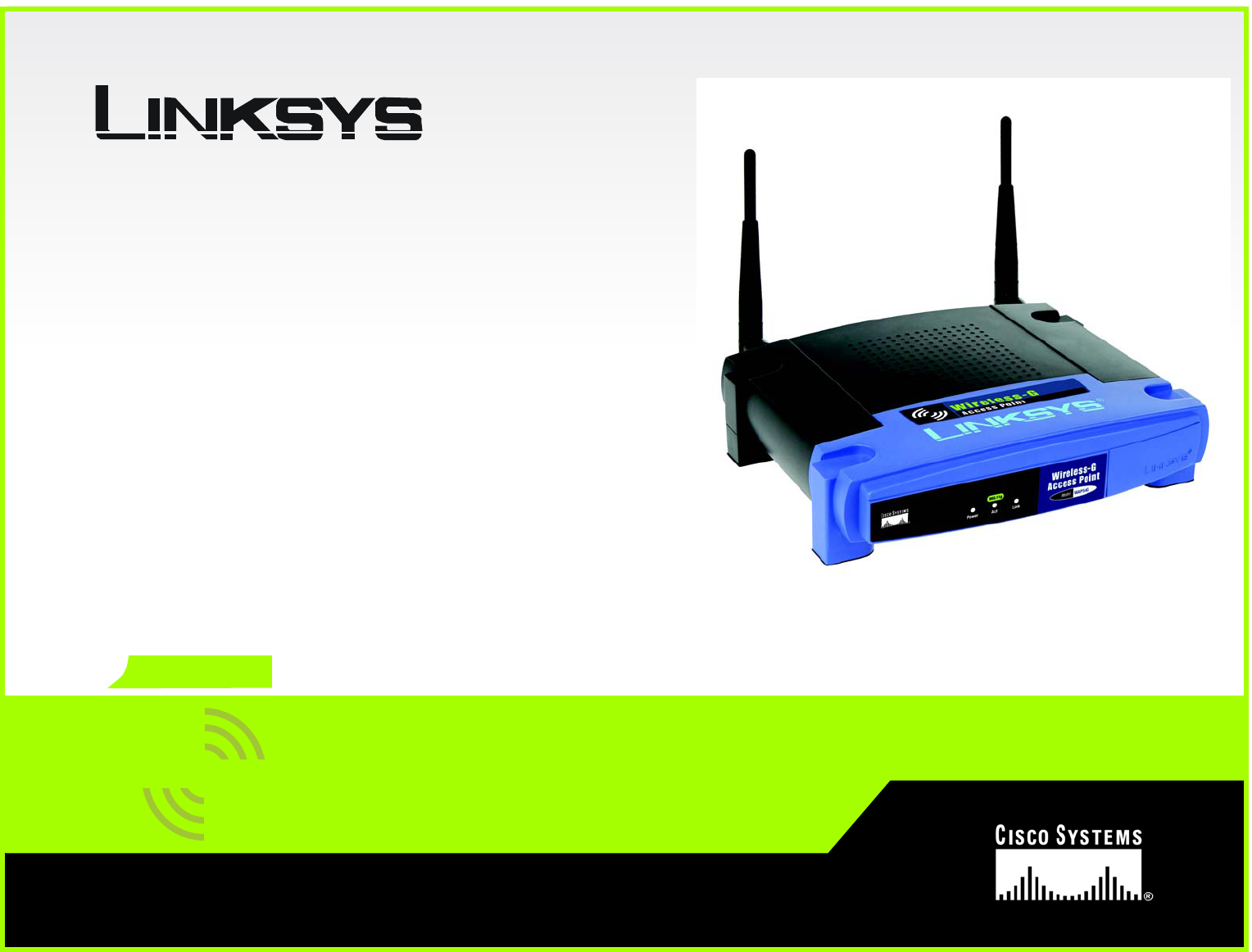
A Division of Cisco Systems, Inc.
®
Model No.
Access Point
Wireless-G
WAP54G v2
User Guide
WIRELESS
GHz
2.4
802.11g

Wireless-G Access Point
Copyright and Trademarks
Specifications are subject to change without notice. Linksys is a registered trademark or trademark of Cisco
Systems, Inc. and/or its affiliates in the U.S. and certain other countries. Copyright © 2004 Cisco Systems, Inc. All
rights reserved. Other brands and product names are trademarks or registered trademarks of their respective
holders.
How to Use this Guide
Your guide to the Wireless-G Access Point has been designed to make understanding networking with the Access
Point easier than ever. Look for the following items when reading this guide:
In addition to these symbols, there are definitions for technical terms that are presented like this:
Also, each figure (diagram, screenshot, or other image) is provided with a figure number and description, like
this:
Figure numbers and descriptions can also be found in the "List of Figures" section in the “Table of Contents”.
This exclamation point means there is a Caution or
warning and is something that could damage your
property or the Access Point.
word: definition.
This checkmark means there is a Note of interest and
is something you should pay special attention to while
using the Access Point.
This question mark provides you with a reminder about
something you might need to do while using the Access Point.
Figure 0-1: Sample Figure Description
wap54g v2-UG-40419 BW

Wireless-G Access Point
Table of Contents
Chapter 1: Introduction 1
Welcome 1
What’s in this Guide? 2
Chapter 2: Planning your Wireless Network 4
Network Topology 4
Roaming 4
Network Layout 5
Chapter 3: Getting to Know the Wireless-G Access Point 6
The Back Panel 6
The Front Panel 7
Chapter 4: Connecting the Wireless-G Access Point 8
Hardware Installation 8
Chapter 5: Setting Up the Wireless-G Access Point 9
Setup Wizard 9
Linksys Wireless Guard Setup 15
Chapter 6: Linksys Wireless Guard 18
Client Software Installation 18
Network Access 21
Your Account 22
Chapter 7: Configuring the Wireless-G Access Point 29
Overview 29
Navigating the Utility 30
Accessing the Utility 31
The Setup Tab 32
The Status Tab 40
The Advanced Tab 41
The Help Tab 45
Appendix A: Troubleshooting 46
Frequently Asked Questions 46
Appendix B: Wireless Security 50
Security Precautions 50
Security Threats Facing Wireless Networks 50

Wireless-G Access Point
Appendix C: Upgrading Firmware 53
Appendix D: Windows Help 54
Appendix E: Glossary 55
Appendix F: Specifications 59
Appendix G: Warranty Information 61
Appendix H: Regulatory Information 62
Appendix I: Contact Information 64

Wireless-G Access Point
List of Figures
Figure 3-1: The Access Point’s Back Panel 6
Figure 3-2: Front Panel 7
Figure 5-1: The Setup Wizard’s Welcome Screen 9
Figure 5-2: Connecting the Access Point 10
Figure 5-3: Select an Access Point 10
Figure 5-4: Enter the Password 11
Figure 5-5: The Configure Network Address Settings Screen 11
Figure 5-6: The Wireless Settings Screen 12
Figure 5-7: The Security Settings Screen 12
Figure 5-8: The WEP Settings Screen 13
Figure 5-9: The WPA-PSK Screen 13
Figure 5-10: The Congratulations Screen 14
Figure 5-11: The Attention Screen 15
Figure 5-12: The Linksys Wireless Guard Setup Screen 15
Figure 5-13: The Securing your Access Point Screen 16
Figure 5-14: Note the New Password Screen 16
Figure 5-15: The Adding Authorized Users Screen 17
Figure 5-16: The Congratulations Screen 17
Figure 6-1: Note 18
Figure 6-2: Configuring Windows Installer 18
Figure 6-3: Exit Applications 19
Figure 6-4: License Agreement 19
Figure 6-5: Destination Location 20
Figure 6-6: Copying Files 20
Figure 6-7: Restart your Computer 21
Figure 6-8: The Network Access Screen 21
Figure 6-9: Member Login 22
Figure 6-10: Home 23

Wireless-G Access Point
Figure 6-11: Network Administration 23
Figure 6-12: Modify Access Control 24
Figure 6-13: Add Guest 24
Figure 6-14: Add Member 25
Figure 6-15: Welcome 25
Figure 6-16: Subscriber Information 26
Figure 6-17: Account Finances 26
Figure 6-18: Credentials Information 27
Figure 6-19: Congratulations 27
Figure 7-1: Password Screen 31
Figure 7-2: The Basic Setup Screen 32
Figure 7-3: WPA Pre-Shared Key Settings 34
Figure 7-4: WPA Radius Settings 34
Figure 7-5: Radius Settings 35
Figure 7-6: WEP Settings 35
Figure 7-7: The Password Screen 36
Figure 7-8: The AP Mode Screen 37
Figure 7-9: The Site Survey screen 37
Figure 7-10: Wireless Repeater diagram 38
Figure 7-11: Wireless Bridge diagram 38
Figure 7-12: The Log screen 39
Figure 7-13: The Status Screen 40
Figure 7-14: The Filters Screen 41
Figure 7-15: The Advanced Wireless screen 42
Figure 7-16: The SNMP screen 44
Figure 7-17: The Help screen 45
Figure C-1: Upgrade Firmware 53

1
Chapter 1: Introduction
Welcome
Wireless-G Access Point
Chapter 1: Introduction
Welcome
Thank you for choosing the Wireless-G Access Point. This Access Point will allow you to network wirelessly better
than ever.
How does the Access Point do all of this? An access point allows for greater range and mobility within your
wireless network while also allowing you to connect the wireless network to a wired environment. Being a dual-
band access point, not only does the Access Point bring you these benefits, it also allows two wireless standards,
802.11g and 802.11b, to communicate with each other. This means that PCs with different wireless standards
can communicate with each other and with a wired network.
But what does all of this mean?
Networks are useful tools for sharing computer resources. You can access one printer from different computers
and access data located on another computer's hard drive. Networks are even used for playing multiplayer video
games. So, networks are not only useful in homes and offices, they can also be fun.
PCs on a wired network create a LAN, or Local Area Network. They are connected with Ethernet cables, which is
why the network is called "wired".
PCs equipped with wireless cards and adapters can communicate without cumbersome cables. By sharing the
same wireless settings, within their transmission radius, they form a wireless network. This is sometimes called
a WLAN, or Wired Local Area Network. The Access Point bridges wireless networks of both 802.11g and 802.11b
standards and wired networks.
Use the instructions in this Guide to help you connect the Access Point, set it up, and configure it to bridge your
different networks. These instructions should be all you need to get the most out of the Access Point.
802.11b: a wireless networking standard that specifies
a maximum data transfer rate of 11Mbps and an
operating frequency of 2.4GHz.
802.11g: a wireless networking standard that
specifies a maximum data transfer rate of
54Mbps, an operating frequency of 2.4GHz, and
backward compatibility with 802.11b devices.
adapter: a device that adds network functionality to your PC
ethernet: network protocol that specifies how data is placed
on and retrieved from a common transmission medium
lan (local area network): the computers and networking
products that make up your local network
network: a series of computers or devices
connected together

2
Chapter 1: Introduction
What’s in this Guide?
Wireless-G Access Point
What’s in this Guide?
This user guide covers the steps for setting up and using the Wireless-G Access Point.
• Chapter 1: Introduction
This chapter describes the Wireless-G Access Point’s applications and this User Guide.
• Chapter 2: Planning your Wireless Network
This chapter describes the basics of wireless networking.
• Chapter 3: Getting to Know the Wireless-G Access Point
This chapter describes the physical features of the Access Point.
• Chapter 4: Connecting the Wireless-G Access Point
This chapter instructs you on how to connect the Access Point to your network.
• Chapter 5: Setting Up the Wireless-G Access Point
This chapter explains how to use the Web-Based Utility to configure the settings on the Access Point and how
to install the setup on the Access Point for the Linksys Wireless Guard.
• Chapter 6: The Linksys Wireless Guard
This chapter explains how to install the client software for Linksys Wireless Guard and other information on
the service.
• Chapter 7: Configuring the Wireless-G Access Point
This chapter explains the use of the Access Point’s Web-based Utility.
• Appendix A: Troubleshooting
This appendix describes some frequently asked questions regarding installation and use of the Wireless-G
Access Point.
• Appendix B: Wireless Security
This appendix explains the risks of wireless networking and some solutions to reduce the risks.
• Appendix C: Upgrading Firmware
This appendix instructs you on how to upgrade the Access Point’s firmware.
• Appendix D: Windows Help.
This appendix describes some of the ways Windows can help you with wireless networking.
• Appendix E: Glossary
This appendix gives a brief glossary of terms frequently used in networking.

3
Chapter 1: Introduction
What’s in this Guide?
Wireless-G Access Point
• Appendix F: Specifications
This appendix provides the Access Point’s technical specifications.
• Appendix G: Warranty Information
This appendix supplies the Access Point’s warranty information.
• Appendix H: Regulatory Information
This appendix supplies the Access Point’s regulatory information.
• Appendix I: Contact Information
This appendix provides contact information for a variety of Linksys resources, including Technical Support.

4
Chapter 2: Planning your Wireless Network
Network Topology
Wireless-G Access Point
Chapter 2: Planning your Wireless Network
Network Topology
A wireless network is a group of computers, each equipped with one wireless adapter. Computers in a wireless
network must be configured to share the same radio channel. Several PCs equipped with wireless cards or
adapters can communicate with one another to form an ad-hoc network.
Linksys wireless adapters also provide users access to a wired network when using an access point, such as the
Wireless-G Access Point, or wireless router. An integrated wireless and wired network is called an infrastructure
network. Each wireless PC in an infrastructure network can talk to any computer in a wired network
infrastructure via the access point or wireless router.
An infrastructure configuration extends the accessibility of a wireless PC to a wired network, and may double the
effective wireless transmission range for two wireless adapter PCs. Since an access point is able to forward data
within a network, the effective transmission range in an infrastructure network may be doubled.
Roaming
Infrastructure mode also supports roaming capabilities for mobile users. Roaming means that you can move your
wireless PC within your network and the access points will pick up the wireless PC's signal, providing that they
both share the same channel and SSID.
Before enabling you consider roaming, choose a feasible radio channel and optimum access point position.
Proper access point positioning combined with a clear radio signal will greatly enhance performance.
infrastructure: a wireless network
that is bridged to a wired network via
an access point.
ad-hoc: a group of wireless devices
communicating directly with each other (peer-
to-peer) without the use of an access point.
roaming: the ability to take a wireless device
from one access point's range to another
without losing the connection.
ssid: your wireless network's name

5
Chapter 2: Planning your Wireless Network
Network Layout
Wireless-G Access Point
Network Layout
The Wireless-G Access Point has been designed for use with 802.11g and 802.11b products. With 802.11g
products communicating with the 802.11b standard, products using these standards can communicate with each
other. The Access point is compatible with 802.11g and 802.11b adapters, such at the PC Cards for your laptop
computers, PCI Card for your desktop PC, and USB Adapters for when you want to enjoy USB connectivity. These
wireless products can also communicate with a 802.11g or 802.11b wireless PrintServer.
When you wish to connect your wired network with your wireless network, the Access Point’s network port can
be used to connect to any of Linksys's switches or routers.
With these, and many other, Linksys products, your networking options are limitless. Go to the Linksys website at
www.linksys.com for more information about wireless products.
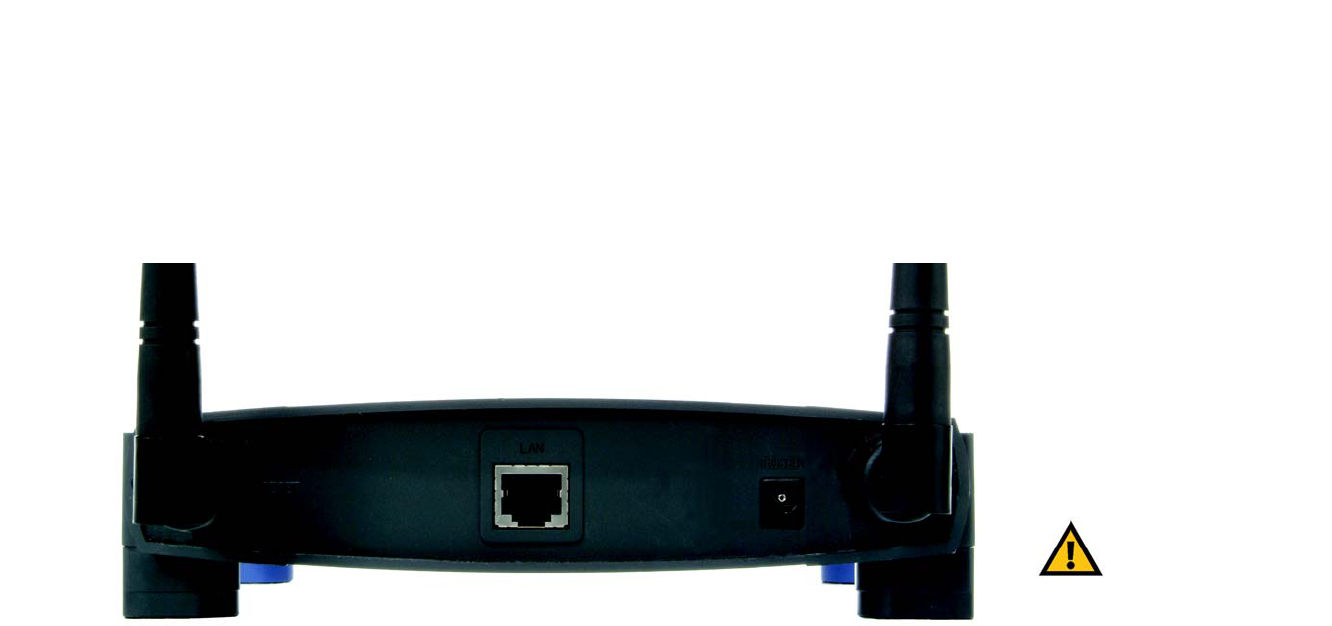
6
Chapter 3: Getting to Know the Wireless-G Access Point
The Back Panel
Wireless-G Access Point
Chapter 3: Getting to Know the Wireless-G Access Point
The Back Panel
The Access Point's ports, where the power cord and network cable are connected, are located on the back panel.
LAN This LAN (Local Area Network) port connects to Ethernet network devices, such as a switch or
router.
Power The Power port is where you will connect the power adapter.
Reset Button There are two ways to Reset the Access Point's factory defaults. Either press the Reset
Button, for approximately ten seconds, or restore the defaults from the Password tab in the
Access Point's Web-Based Utility.
With these, and many other, Linksys products, your networking options are limitless. Go to the Linksys website at
www.linksys.com for more information about products that work with the Access Point.
Important: Resetting the Access Point will
erase all of your settings (WEP Encryption,
Wireless and LAN settings, etc.) and replace
them with the factory defaults. Do not reset
the Access Point if you want to retain these
settings.
Figure 3-1: The Access Point’s Back Panel
port: the connection point on a computer or networking
device used for plugging in cables or adapters

7
Chapter 3: Getting to Know the Wireless-G Access Point
The Front Panel
Wireless-G Access Point
The Front Panel
The Access Point's LEDs, where information about network activity is displayed, are located on the front panel.
Power Green. The Power LED lights up when the Access Point is powered on.
Act Green. If the Act LED is flickering, the Access Point is actively sending or receiving data to or
from one of the devices over the LAN port.
Link Green. The Link LED lights whenever the Access Point is successfully connected to a device
through the LAN port.
Figure 3-2: Front Panel

8
Chapter 4: Connecting the Wireless-G Access Point
Hardware Installation
Wireless-G Access Point
Chapter 4: Connecting the Wireless-G Access Point
Hardware Installation
1. Locate an optimum location for the Access Point. The best place for the Access Point is usually at the center
of your wireless network, with line of sight to all of your PCs and wireless accessories.
2. Fix the direction of the antenna. Try to place it in a position that will best cover your wireless network.
Normally, the higher you place the antenna, the better the performance will be. The antenna's position
enhances the receiving sensitivity.
3. Connect a standard Ethernet network cable to the Access Point. Then, connect the other end of the Ethernet
cable to a switch or router. The Access Point will then be connected to your 10/100 Network.
4. Connect the AC Power Adapter to the Access Point's Power Socket. Only use the power adapter supplied with
the Access Point. Use of a different adapter may result in product damage.
Now that the hardware installation is complete, proceed to Chapter 5: Setting Up the Wireless-G Access Point, for
directions on how to set up the Access Point.
tcp/ip: a set of instructions PCs use to
communicate over a network.
HAVE YOU:Enabled TCP/IP on your PCs? PCs
communicate over the network with this
protocol. Refer to Appendix D: Windows Help
for more information on TCP/IP.
hardware: the physical aspect of
computers, telecommunications, and
other information technology devices
NOTE: If you are setting up an Infrastructure
Network, all of your wireless devices must be
in Infrastructure mode in order to function
within the network. Similarly, if your network
is an Ad-Hoc Network, all of your wireless
devices must operate in Ad-hoc mode in order
for all other wireless devices to communicate.

9
Chapter 5: Setting Up the Wireless-G Access Point
Setup Wizard
Wireless-G Access Point
Chapter 5: Setting Up the Wireless-G Access Point
Setup Wizard
Now that you've connected the Access Point to your wired network, you are ready to begin setting it up. This
Setup Wizard will take you through all the steps necessary to configure the Access Point.
1. Insert the Setup Wizard CD into your PC's CD-ROM drive. Your PC must be on your wired network to set up the
Access Point.
2. The Setup Wizard's Welcome screen should appear on your monitor. If it does not, this means the Setup
Wizard is not automatically running as it should. Start the Setup Wizard manually by clicking the Start button,
selecting Run, and typing d:\setup.exe (where "D" is your PC's CD-ROM drive). Click the Setup button to
continue this Setup Wizard. Clicking the User Guide button opened this Guide. To exit this Setup Wizard, click
the Exit button.
Figure 5-1: The Setup Wizard’s Welcome Screen
Note: The Access Point should be set up through a
wired network connection as shown in Chapter 4:
Connecting the Wireless-G Access Point. If you wish
to set up the Access Point wirelessly, the wireless
computer will require you to use the Linksys default
settings. These settings can then be changed with
the Setup Wizard or Web-based Browser Utility

10
Chapter 5: Setting Up the Wireless-G Access Point
Setup Wizard
Wireless-G Access Point
3. The next screen displayed displays how the Access Point should be connected while running this Setup
Wizard. Optimally, you should perform this setup through a PC on your wired network. Click the Next button
to continue or Exit to exit the Setup Wizard.
4. The Setup Wizard will run a search for the Access Point within your network and then display a list along with
the status information for each access point. If this is the only access point on your network, it will be the only
one displayed. If there are more than one displayed, select the Access Point by clicking on it and click the Yes
button to continue or No to exit the Setup Wizard.
Figure 5-3: Select an Access Point
Figure 5-2: Connecting the Access Point

11
Chapter 5: Setting Up the Wireless-G Access Point
Setup Wizard
Wireless-G Access Point
5. You will be asked to sign onto the Access Point you've selected. Enter the Password you've assigned. If none
has been assigned, enter the default password: admin. Then, click the OK button. (This password can be
changed from the Web-based Utility's Password tab.)
6. The Configure Network Address Settings screen will appear next. Enter an IP Address, Subnet Mask, and the
IP Address of your network Gateway. Then, click the Next button to continue or Back to return to the previous
page.
• IP Address. This IP address must be unique to your network. (The default IP address is 192.168.1.245.)
• Subnet Mask. The Access Point's Subnet Mask must be the same as your Ethernet network.
• Gateway. This IP address should be the IP address of the gateway device that allows for contact between
the Internet and the local network.
Figure 5-4: Enter the Password
Figure 5-5: The Configure Network Address Settings Screen
ip address: the address used to identify a computer
or device on a network
ip (internet protocol): a protocol used to send data over a
network
gateway: a device that interconnects networks with
different, incompatible communications protocols

12
Chapter 5: Setting Up the Wireless-G Access Point
Setup Wizard
Wireless-G Access Point
7. The Wireless Settings screen should now appear. Enter your wireless network's SSID and select the channel
at which the network broadcasts its wireless signal. Also enter a Device Name to prevent any confusion when
using multiple Access Points. Then, click the Next button to continue or Back to return to the previous page.
• SSID. The SSID is the unique name shared among all points in a wireless network. The SSID must be
identical for all points in the wireless network. It is case sensitive and must not exceed 32 characters,
which may be any keyboard character. Make sure this setting is the same for all points in your wireless
network.
• Channel. Select the appropriate channel from the list provided to correspond with your network settings,
between 1 and 11. All points in your wireless network must use the same channel in order to function
correctly.
• Device Name. The Device Name is a unique name given to the Access Point to prevent confusion when
using multiple Access Points.
8. The Security Settings screen will appear next. From this screen, you can set the level of security you desire
for your network. Select from WEP, WPA-Personal, WPA Enterprise, and Linksys Wireless Guard. All points in
your wireless network must use the same security method.
Figure 5-6: The Wireless Settings Screen
Figure 5-7: The Security Settings Screen

13
Chapter 5: Setting Up the Wireless-G Access Point
Setup Wizard
Wireless-G Access Point
• WEP. From this screen, you can set the level of encryption you desire for your network, along with
selecting Passphrases and/or encryption keys.
The WEP key can consist of the letters "A" through "F" and the numbers "0" through "9" and should be
10 characters in length for 64-bit encryption or 26 characters in length for 128-bit encryption.
• WPA Personal. With WPA Personal (WPA PSK, or Pre-Shared Keys) you have two encryption options, TKIP
and AES, with dynamic encryption keys. Select the type of algorithm, TKIP or AES. Enter a Pre-Shared
Key of 8-32 characters.
• WPA-Enterprise. This option is for corporate wireless networks only and uses a special authentication
server. To choose this option, select Disable. You will need to enable the option in the web-based utility.
Refer to Chapter 7: Configuring the Wireless-G Access Point.
• Linksys Wireless Guard. With this subscription service, you get the highest security of WPA RADIUS, but
without having to build your own RADIUS network. If you select this option, follow the step-by-step
instructions in the next section, Linksys Wireless Guard.
Then, click the Next button to continue or Back to return to the previous page.
For more information on wireless security, refer to Appendix B: Wireless Security.
Figure 5-8: The WEP Settings Screen
Figure 5-9: The WPA-PSK Screen
bit: a binary digit
encryption: encoding data transmitted in a network

14
Chapter 5: Setting Up the Wireless-G Access Point
Setup Wizard
Wireless-G Access Point
9. At this point, the configuration performed with the Setup Wizard is complete. To configure any other Access
Points in your network, you can run this Setup Wizard again.
Click the Exit button to exit the Setup Wizard.
For more advanced configuration, you can go to Chapter 7: Configuring the Wireless-G Access Point.
Figure 5-10: The Congratulations Screen

15
Chapter 5: Setting Up the Wireless-G Access Point
Linksys Wireless Guard Setup
Wireless-G Access Point
Linksys Wireless Guard Setup
Linksys Wireless Guard is a subscription service that gives you WPA RADIUS without having to build your own
RADIUS network. Follow the instructions below. To learn more about Linksys Wireless Guard, go to
www.linksys.com/wirelessguard. If you need help with setting up Linksys Wireless Guard, contact us at
wirelessguard@linksys.com or call 888-231-5506.
1. After clicking on Linksy Wireless Guard for your security selection, this screen will appear. Before you
continue with the setup, make sure your computer meets the following requirements.
• Windows XP or Windows 2000 operating system
• 128 MB RAM
• 50MB free disk space
• A wireless network interface with a driver that supports WPA security
• Must be connected to the Internet through a broadband connection (DSL, cable, other)
If you meet these requirements, click Continue to sign up for the Linksys Wireless Guard service, or click Cancel
to cancel the setup.
2. This screen guides you through the registration process. Enter your user name, password, first and last name,
E-mail address, and a security question and answer below. Then, click Next to continue or Exit if you want to
quit the Setup Wizard.
• User Name and Password. Enter the user name you want to use into the User Name field. Enter the
Password you want to use in the Password field.
• Confirm Password. Enter the password again into the Confirm Password field.
• First and Last Name. Enter your first and last names into the fields.
• E-mail address. Enter your E-mail address into the field.
• Security Question and Answer. Select a security question from the Security Question drop-down menu to
help identify you if you forget your password. Enter the answer to your selected question in the Security
Answer field.
Figure 5-11: The Attention Screen
Figure 5-12: The Linksys Wireless Guard Setup Screen

16
Chapter 5: Setting Up the Wireless-G Access Point
Linksys Wireless Guard Setup
Wireless-G Access Point
3. When the next screen appears, your Access Point will be automatically configured. Make sure that the correct
access point is selected and that the name is correct. Also, make sure that the SSID is correct. Click Next to
add this Access Point to your network or click Back to return to the previous screen.
4. For security reasons, the password has been automatically changed. Please note the new password before
continuing or you won’t be able to access the Access Point later. After writing down the new password, select
I have noted the new password, then click OK.
Figure 5-13: The Securing your Access Point Screen
Figure 5-14: Note the New Password Screen
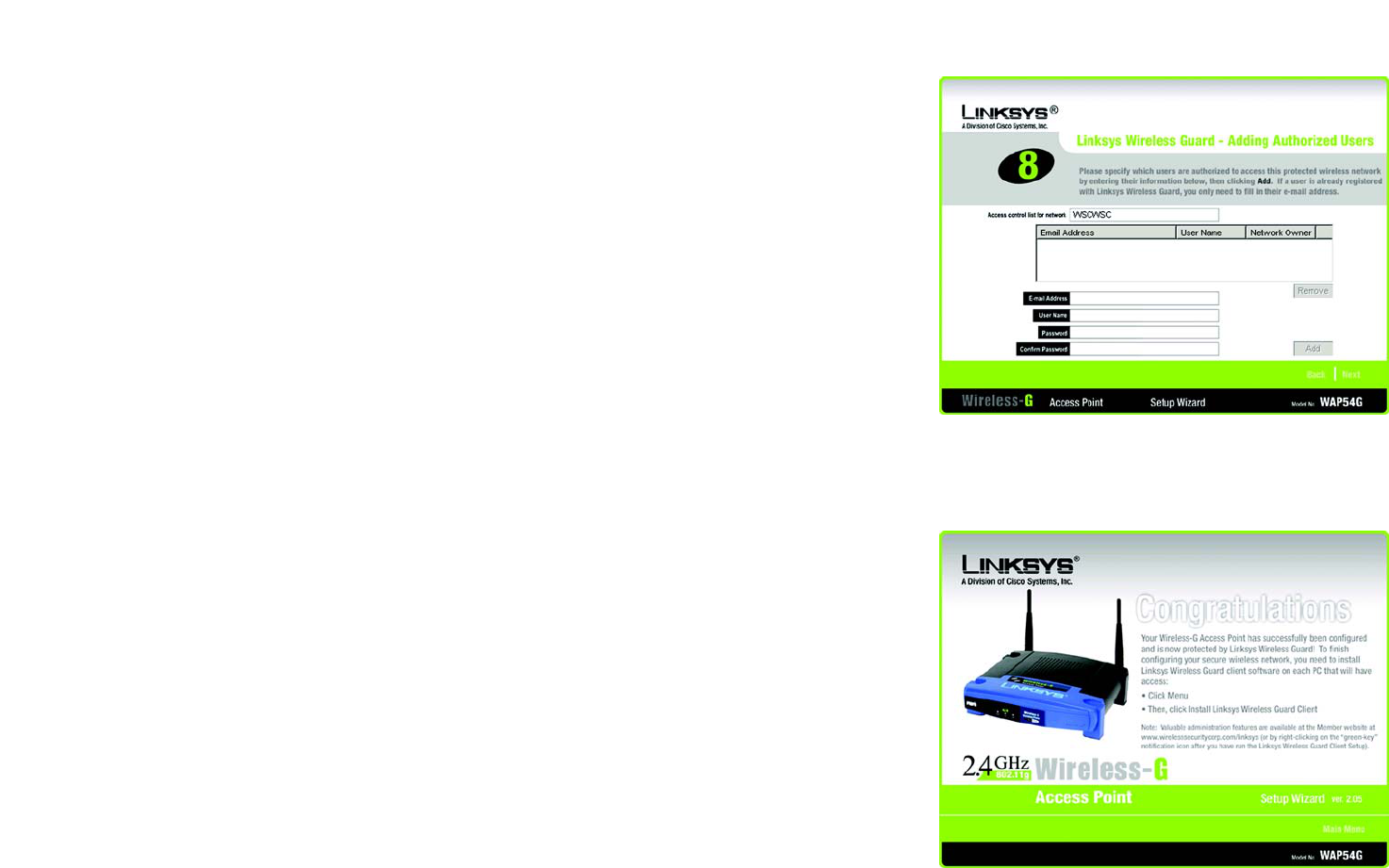
17
Chapter 5: Setting Up the Wireless-G Access Point
Linksys Wireless Guard Setup
Wireless-G Access Point
5. When the next screen appears, you will specify which users you will allow access to this protected network.
Enter the E-mail address, User Name, Password, then Confirm Password for each user. Then, click Add. To
remove a user from the list, select the user, then click Remove.
6. The Access Point is now configured for Linksys Wireless Guard. To finish configuring your wireless network,
you will need to install the Linksys Wireless Guard client software for each PC that will have access. Click
Main Menu, then click Linksys Wireless Guard Client.
To add more Access Points to your Linksys Wireless Guard network,
run the Linksys Wireless Guard Setup again for each Access Point.
Figure 5-15: The Adding Authorized Users Screen
Figure 5-16: The Congratulations Screen

18
Chapter 6: Linksys Wireless Guard
Client Software Installation
Wireless-G Access Point
Chapter 6: Linksys Wireless Guard
This chapter is only for users who have signed up for Linksys Wireless Guard to secure their network and have
configured the Access Point for Linksys Wireless Guard. (Refer to Chapter 5: Setting up the Wireless-G Access
Point.)
You will now need to install the client software needed to securely connect a PC to your Access Point that is
protected by Linksys Wireless Guard. This chapter will also show you how to access your protected network, and
manage your account.
Client Software Installation
1. If you haven’t already done so, on the Main Menu of the Setup-CD-ROM, click Linksys Wireless Guard
Client. The screen in Figure 6-1 will appear. To install the software on this PC, click Continue. Click Cancel to
cancel the installation.
2. A screen will appear to notify you that the setup is in process. Wait until the next screen appears. Only if you
want to end the installation process, click Cancel.
Figure 6-1: Note
IMPORTANT: Make sure that you have signed up
for Linksys Wireless Guard and that you have
configured the Access Point for Linksys Wireless
Guard before starting the installation of the client
software.
Figure 6-2: Configuring Windows Installer

19
Chapter 6: Linksys Wireless Guard
Client Software Installation
Wireless-G Access Point
3. The next screen informs you to close all other applications before continuing. If no other applications are
open, click Next fo continue. If you want to exit to close your other applications, click Cancel.
4. A license agreement will appear next. Scroll down or press PAGE DOWN to read the entire agreement. To
accept the terms and continue the installation, click Yes. To quit the installation, Click No.
Figure 6-3: Exit Applications
Figure 6-4: License Agreement

20
Chapter 6: Linksys Wireless Guard
Client Software Installation
Wireless-G Access Point
5. On this screen, you will be informed where the Linksys Wireless Guard will be installed. To install to the folder,
click Next. If you want to choose a different location for the folder, click the Browse button and select the
location.
Click Back to return to the previous screen. Click Cancel to cancel the installation.
6. The program files will start copying. Click Next to continue.
Click Back to return to the previous screen. Click Cancel to cancel the installation.
Figure 6-5: Destination Location
Figure 6-6: Copying Files
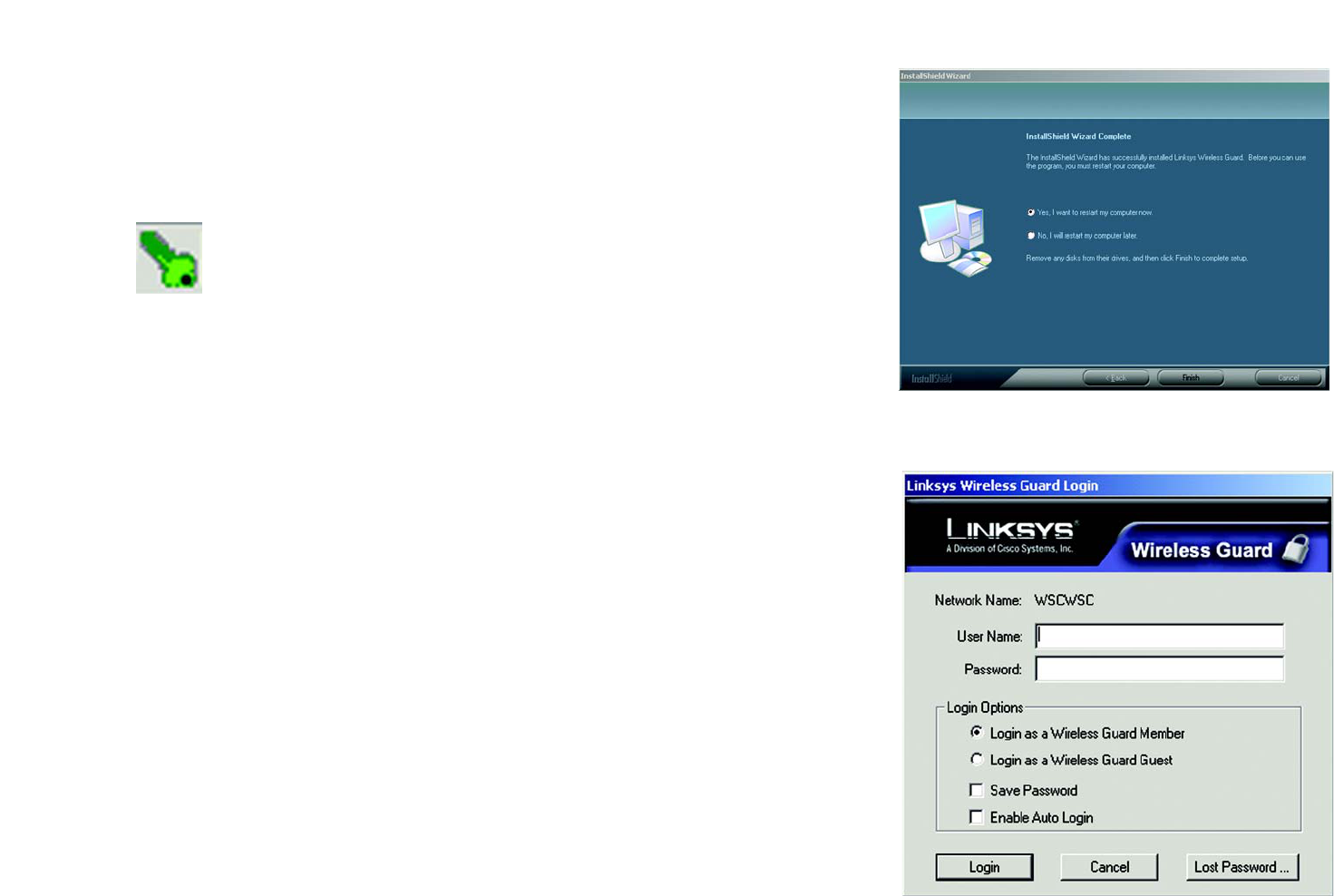
21
Chapter 6: Linksys Wireless Guard
Network Access
Wireless-G Access Point
7. The Linksys Wireless Guard is successfully installed. Before you can use the program, you must restart your
computer. Select Yes to restart your computer now. Select No to restart your computer at a later time.
Remove any disks that are in their drives, then click Finish.
8. After the Linksys Wireless Guard is installed, a key icon will be installed on the right-side of the system tray at
the bottom of your screen. The color of the key will change with the status of the network connection. The
most common colors are described below.
Green - Connected.
Green with Red X - Connected, but waiting for authentication.
Gray - Not connected.
Red - Connected to a network that is not protected by Linksys Wireless Guard.
Network Access
After Linksys Wireless Guard is installed, any time you access a Linksys Wireless Guard protected network, this
screen will appear. To access your network, click Login as a Wireless Guard Member, or if you are a guest,
click Login as a Wireless Guard Guest. Enter your user name and password, then click Login.
Login as a Wireless Guard Member. Select this option if you are a registered member.
Login as a Wireless Guard Guest. Select this option if you are a registered guest member. The guest must first
be added as a guest in the Membership and Network Administration Website. See the Add a Guest section,
below.
Save Password. Select this if you want the system to remember your password so you don’t have to enter it
when you log in.
Enable Auto Login. Select this if you want the system to bypass the log in.
Click Cancel to cancel the login or if you forget your password, click Lost Password.
Figure 6-7: Restart your Computer
Figure 6-8: The Network Access Screen

22
Chapter 6: Linksys Wireless Guard
Your Account
Wireless-G Access Point
Your Account
This section explains how to access your account, how to add a guest, how to add another member to your
account, and how to secure and unprotect the Linksys Wireless Guard network.
For more detailed information on your account and the website, click on your computer’s Start button, select the
Linksys Wireless Guard folder, then click Linksys Wireless Guard Help. For further information on the Linksys
Wireless Guard only, you can contact Linksys Wireless Guard Technical Support at 888 231-5506 or
E-mail us at wirelessguard@linksys.com.
Accessing your Account
Right-click on the green Wireless Guard Network key icon, then click View Membership and Network
Administraton Website to log in to the Linksys Wireless Guard website.
You can also click on your computer’s Start button, select the Linksys Wireless Guard folder, then click
Membership and Network Administration Website.
1. The screen in Figure 6-9 will appear. Enter the administrator’s user name and password in the fields. Click
Login.
2. The Wireless Guard Member Website home screen will appear. From this website, you can modify your
member or billing profile, view information about your account or subscription, add or remove members,
modify access to members and guests, change network settings, and download updates and documentation.
There is an extensive Help tab to help you with everything on the website. The instructions for adding a guest
or member, or securing and unprotecting your network are also explained below.
Figure 6-9: Member Login

23
Chapter 6: Linksys Wireless Guard
Your Account
Wireless-G Access Point
Add a Guest
1. On the Wireless Guard Member Website home screen, Figure 6-10, click the Network Admin tab.
2. The screen in Figure 6-11 will appear. Under Network Administration, click Modify Access Control.
Figure 6-10: Home
Figure 6-11: Network Administration

24
Chapter 6: Linksys Wireless Guard
Your Account
Wireless-G Access Point
3. The screen in Figure 6-12 will appear. Under Guests, click Add Guest.
4. The screen in Figure 6-13 will appear. Enter the Guest User Name, Guest First Name, Guest Last Name,
Password, Password Verify, Access Duration, then click Submit.
Guest User Name. Enter a user name of the guest you want to add.
Guest First Name. The first name of the guest you want to add.
Guest Last Name. The last name of the guest you want to add.
Password. Enter a password that’s at least six characters for the guest you want to add.
Password Verify. Enter the password again.
Access Duration. Enter the length of time that the guest will be on the network in hours.
5. The guest will need to install the Linksys Wireless Guard Client software on his PC. The software can be
downloaded from the Setup CD-ROM or from Linksys.com/support. Refer to Client Software Installation at the
beginning of this chapter.
Figure 6-12: Modify Access Control
Figure 6-13: Add Guest

25
Chapter 6: Linksys Wireless Guard
Your Account
Wireless-G Access Point
Add a Member
To add a member, follow instructions for Add a Guest, steps 1 through 3 above, except in step 3, click Add
Member.
The screen in Figure 6-14 will appear. Registered members can enter their Email address in the field and select
the duration for access from the drop-down menu. If you want this network member to have the authority to put
the network into Fallback Mode in case network security is lost, select Permission to Initiate Network
Fallback. When finished, click Submit.
To register as a member for Linksys Wireless Guard, refer to the following instructions, then when finished with
registration, return to this screen.
The member will need to install the Linksys Wireless Guard Client software on his PC. The software can be
downloaded from the Setup CD-ROM or from Linksys.com/support. Refer to Client Software Installation at the
beginning of this chapter.
Member Registration
1. Right-click on the green Wireless Guard Network key icon, then click Register Member.
2. The Welcome screen will appear. Click Next.
Figure 6-14: Add Member
Figure 6-15: Welcome

26
Chapter 6: Linksys Wireless Guard
Your Account
Wireless-G Access Point
3. When the Enter subscriber informatlion screen appears, enter the first and last names, the phone number, if
desired, then the E-mail address of the new member. Click Next.
Click Back to return to the previous screen. Click Cancel to cancel the member registration.
4. When the next screen appears, choose who will be paying for the account. If the new member will be paying
for the account, click I will pay for my own subscription. I will enter my billing information on the web
site later. If the administrator will be paying for the account, click Another member will be paying for my
subscription. Click Next.
Click Back to return to the previous screen. Click Cancel to cancel the member registration.
Figure 6-17: Account Finances
Figure 6-16: Subscriber Information

27
Chapter 6: Linksys Wireless Guard
Your Account
Wireless-G Access Point
5. When this screen appears, enter the information you will be using with the account. Enter a user name,
password, then the password again. Also select a security question and answer in case you forget your
password in the future. Click Next to continue.
Click Back to return to the previous screen. Click Cancel to cancel the member registration.
6. When the congratulations screen appears you will be successfully registered for Linksys Wireless Guard.
Click Finish.
7. You should now ask the administrator to add you to his Wireless Guard Protected Network’s Access Control
List. To do so, The network administrator needs to return to the Add Member screen in Figure 6-14, above.
Figure 6-18: Credentials Information
Figure 6-19: Congratulations

28
Chapter 6: Linksys Wireless Guard
Your Account
Wireless-G Access Point
Securing or Unprotecting your Wireless Guard Network
There may be some instances where you would want to completely unprotect your network connection so it is
not using the Wireless Guard security. For example, if you take your laptop to another location to give a
presentation, and connect to a network that is running 802.1x security, the Linksys Wireless Guard software on
your laptop will prevent you from logging in to another network. You will need to manually unprotect your
network connection so you can log in. When you come back to your own network, you won't have to manually re-
secure the network connection. Linksys Wireless Guard will recognize it and automatically reinstate security.
To unprotect a network
Right-click on the green Wireless Guard Network key icon on the right-side of the system tray at the bottom of
your screen. Select Unprotect this Network Connection from the menu.
When the screen asks if you're sure you want to unprotect the network, click Yes.
To secure an unprotected network
Right-click on the green Wireless Guard Network key icon. Select Secure this Network Connection from the
menu.
When the screen asks if you're sure you want to secure the network. Click Yes.
For more detailed information on your account and the website, click on your
computer’s Start button, select the Linksys Wireless Guard folder, then click
Linksys Wireless Guard Help.

29
Chapter 7: Configuring the Wireless-G Access Point
Overview
Wireless-G Access Point
Chapter 7: Configuring the Wireless-G Access Point
Overview
The Access Point has been designed to be functional right out of the box, with the default settings in the Setup
Wizard. However, if you'd like to change these settings, the Access Point can be configured through your web
browser with the Web-Based Utility. This chapter explains how to configure the Access Point in this manner.
For your convenience, use the Access Point’s Web-based Utility to administer it. This chapter will explain all of
the functions in this Utility. The Utility can be accessed via Microsoft Internet Explorer or Netscape Navigator
through use of a computer connected with an Ethernet cable to the Access Point.
For a basic network setup, most users only have to use the following screens of the Utility:
• Basic Setup
On the Basic Setup screen, enter your basic network settings here.
• Password
Click the Setup tab and then select the Password screen. The Access Point’s default password is admin. To
secure the Access Point, change the Password from its default.
Have You: Enabled TCP/IP on your PCs? PCs
communicate over the network with this
protocol. Refer to Appendix D: Windows Help
for more information on TCP/IP.
Note: The Access Point is designed to function
properly after using the Setup Wizard. This
chapter is provided solely for those who wish
to perform more advanced configuration or
monitoring.
browser: an application that provides a way to look at and
interact with all the information on the World Wide Web.

30
Chapter 7: Configuring the Wireless-G Access Point
Navigating the Utility
Wireless-G Access Point
Navigating the Utility
There are four main tabs: Setup, Status, Advanced, and Help. Additional screens will be available from the main
tabs.
Setup
•Basic Setup. Enter the Internet connection and network settings on this screen.
•Password. Change the Access Point’s Password and change its settings back to their defaults from this
screen.
•AP Mode. From this screen, you can configure how the Access Point will work with other access points in
your network.
•Log. You can view or save, even email, activity logs from this screen.
Status
• This screen will display current information on the Access Point, its settings, and its performance.
Advanced
•Filters. From this screen, you can allow or prevent access to your network.
•Advanced Wireless. From this screen, you can configure the Access Point’s more advanced wireless settings.
•SNMP. This screen allows you to customize the Simple Network Management Protocol (SNMP) settings.
Help
• For help on the various tabs in this Web-based Utility, go to this screen.
firmware: the programming code that runs a
networking device
snmp: the standard e-mail protocol on the Internet

31
Chapter 7: Configuring the Wireless-G Access Point
Accessing the Utility
Wireless-G Access Point
Accessing the Utility
To access the Web-based Utility of the Access Point, launch Internet Explorer or Netscape Navigator, and enter
the Access Point’s default IP address, 192.168.1.245, in the Address field. Press the Enter key.
Open your web browser and type the IP Address you entered in the Setup Wizard. (The default IP address is
192.168.1.245.) (Should you need to learn what IP Address the Access Point presently uses, run the Setup Wizard
again. It will scan the Access Point and give you its IP Address.) Press the Enter key and the following screen will
appear. Leave the User Name field blank. The first time you open the Web-Based Utility, use the default password
admin. You can set a new password from the Password tab.
static ip address: a fixed address assigned to
a computer or device connected to a network
Figure 7-1: Password Screen

32
Chapter 7: Configuring the Wireless-G Access Point
The Setup Tab
Wireless-G Access Point
The Setup Tab
Basic Setup
The first screen that appears displays the Basic Setup screen. This allows you to change the Access Point's
general settings. Change these settings as described here and click Save Settings to apply your changes or
Cancel Changes to cancel your changes. If you require online help, click Help.
•Firmware. This will display the Access Point's current firmware version. Firmware can be upgraded from
the Help tab.
•AP Name. You may assign any name to the Access Point. Unique, memorable names are helpful, especially
if you are employing multiple access points on the same network. Verify this is the name you wish to use and
click Save Settings to set it.
LAN
The selections under this heading allow you to configure the Access Point’s connection to your Ethernet (wired)
network.
•Configuration Type. Select Static IP Address if your ISP provided you with the IP Address, Subnet Mask,
and Gateway address or select Automatic Configuration - DHCP if your ISP assigns IP addresses via a DHCP
server.
The following fields apply ONLY when the Static IP Address option is selected:
•IP Address. The IP address must be unique to your network. We suggest you use the default IP address of
192.168.1.245. This is a private IP address, so there is no need to purchase a separate IP address from your
service provider.
•Subnet Mask. The Subnet Mask must be the same as that set on your Ethernet network.
•Gateway. If you have assigned a static IP address to the Access Point, then enter the IP address of your
network’s Gateway, such as a router, in the Gateway field. If your network does not have a Gateway, then
leave this field blank.
Figure 7-2: The Basic Setup Screen
dhcp: a networking protocol that allows administrators to
assign temporary IP addresses to network computers by
"leasing" an IP address to a user for a limited amount of
time, instead of assigning permanent IP addresses.
firmware: programming code that runs a networking device
isp (internet service provider): a company that provides
access to the Internet
static ip address: a fixed address assigned to a computer
or device that is connected to a network
subnet mask: an address code that determines the size
of the network

33
Chapter 7: Configuring the Wireless-G Access Point
The Setup Tab
Wireless-G Access Point
Wireless
The selections under this heading allow you to configure the Access Point’s connection to your wireless network.
•Mode. Select Mixed and both Wireless-G and Wireless-B computers will be allowed on the network, but the
speed will be reduced. Select G-Only for maximum speed with Wireless-G products only. The final selection,
B-Only, allows only Wireless-B products on the network.
•SSID. The SSID is the unique name shared among all points in a wireless network. The SSID must be
identical for all points in the wireless network. It is case-sensitive and must not exceed 32 alphanumeric
characters, which may be any keyboard character. Make sure this setting is the same for all points in your
wireless network. For added security, you should change the SSID from the default name, linksys, to a
unique name.
•SSID Broadcast. Allows the SSID to be broadcast on your network. You may want to enable this function
while configuring your network, but make sure that you disable it when you are finished. With this enabled,
someone could easily obtain the SSID information with site survey software and gain unauthorized access to
your network. Click Enable to broadcast the SSID to all wireless devices in range. Click Disable to increase
network security and prevent the SSID from being seen on networked PCs.
•Channel. Select the appropriate channel from the list provided to correspond with your network settings,
between 1 and 11. All points in your wireless network must use the same channel in order to function
correctly.
•Wireless Security. To enable wireless security, through WPA or WEP encryption, select the Enable radio
button. To disable such security, select the radio button by Disable. To change the security settings for your
network, click the Edit Security Settings button. A notification window will ask if you wish to change the
settings. Click OK to continue or Cancel to return to the Basic Setup tab.
software: instructions for the computer
wpa: a wireless security protocol using TKIP (Temporal
Key Integrity Protocol) encryption, which can be used in
conjunction with a RADIUS server.
wep: a method of encrypting network data transmitted
on a wireless network for greater security

34
Chapter 7: Configuring the Wireless-G Access Point
The Setup Tab
Wireless-G Access Point
Wireless Security Settings
The Wireless Security settings configure the security of your wireless network. There are four wireless security
mode options supported by the Access Point: WPA Pre-Shared Key, WPA RADIUS, RADIUS, and WEP. (WPA stands
for Wi-Fi Protected Access, which is a security standard stronger than WEP encryption. WEP stands for Wired
Equivalent Privacy, while RADIUS stands for Remote Authentication Dial-In User Service.) These four are briefly
discussed here. For detailed instructions on configuring wireless security for the Access Point, turn to “Appendix
B: Wireless Security.”
WPA Pre-Shared Key. WPA gives you two encryption methods, TKIP and AES, with dynamic encryption keys.
Select the type of algorithm, TKIP or AES. Enter a WPA Shared Key of 8-32 characters. Then enter a Group Key
Renewal period, which instructs the Access Point how often it should change the encryption keys.
WPA RADIUS. This option features WPA used in coordination with a RADIUS server. (This should only be used
when a RADIUS server is connected to the Access Point.) First, select the type of WPA algorithm you want to use,
TKIP or AES. Enter the RADIUS server’s IP Address and port number, along with a key shared between the Access
Point and the server. Last, enter a Key Renewal Timeout, which instructs the Access Point how often it should
change the encryption keys.
If you want to get the security of WPA RADIUS, but without having to build your own RADIUS network, Linksys
offers Linksys Wireless Guard, a subscription service. For more information, click CLICK HERE.
Figure 7-4: WPA Radius Settings
Figure 7-3: WPA Pre-Shared Key Settings
server: any computer whose function in a
network is to provide user access to files,
printing, communications, and other services
tkip: a wireless encryption protocol that provides
dynamic encryption keys for each packet transmitted

35
Chapter 7: Configuring the Wireless-G Access Point
The Setup Tab
Wireless-G Access Point
RADIUS. This option features WEP used in coordination with a RADIUS server. (This should only be used when a
RADIUS server is connected to the Access Point.) First, enter the RADIUS server’s IP Address and port number,
along with a key shared between the Access Point and the server. Then, select a Default Transmit Key (choose
which Key to use), and a level of WEP encryption, 64 bits 10 hex digits or 128 bits 26 hex digits. Last, either
generate a WEP key using the Passphrase or enter the WEP key manually.
WEP. WEP is a basic encryption method, which is not as secure as WPA. To use WEP, select a Default Transmit Key
(choose which Key to use), and a level of WEP encryption, 64 bits 10 hex digits or 128 bits 26 hex digits. Then
either generate a WEP key using the Passphrase or enter the WEP key manually.
Change these settings as described here and click the Save Settings button to apply your changes or Cancel
Changes to cancel your changes. For help on any of these settings, click the Help button. For detailed
instructions on configuring wireless security for the Access Point, turn to “Appendix B: Wireless Security.”
Figure 7-5: Radius Settings
Figure 7-6: WEP Settings
passphrase: used much like a password, a passphrase
simplifies the WEP encryption process by automatically
generating the WEP encryption keys for Linksys products

36
Chapter 7: Configuring the Wireless-G Access Point
The Setup Tab
Wireless-G Access Point
Password
The Password screen allows you to change the Access Point's password and restore factory defaults.
Changing the sign-on password for the Access Point is as easy as typing the password into the AP Password
field. Then, type it again into the second field to confirm.
To restore the Access Point's factory default settings, click the Yes button beside Restore Factory Defaults.
To back up your Access Point configuration, click the Backup button. To restore the backed-up configuration,
click the Restore button.
Click the Save Settings button to apply your changes or Cancel Changes to cancel your changes. If you require
online help, click the Help button.
Figure 7-7: The Password Screen

37
Chapter 7: Configuring the Wireless-G Access Point
The Setup Tab
Wireless-G Access Point
AP Mode
LAN MAC Address
The Access Point offers five modes of operation: Access Point, AP (Access Point) Client, Wireless Repeater, and
Wireless Bridge. For the bridging mode and Repeater mode, make sure the channel, SSID, and WEP keys are the
same.
Access Point - The Operational Mode is set to Access Point by default. This connects your wireless PCs to a
wired network. In most cases, no change is necessary.
AP (Access Point) Client - When set to Access Point Client mode, the Access Point Client is able to talk to one
remote access point within its range. This mode allows the Access Point Client to act as a client of a remote
access point. The Access Point Client cannot communicate directly with any wireless clients. A separate network
attached to the Access Point Client can then be wirelessly bridged to the remote access point. Enter the required
LAN MAC address of the remote access point in the Remote AP MAC Address field.
To select an available access point, click the Site Survey button and choose from the access points listed by
clicking on the radio button for the appropriate access point and clicking the close button. If you do not see an
access point listed, click the Refresh button and another survey will be performed.
IMPORTANT: For all modes of operation EXCEPT
Access Point, the remote access point must be a
second Linksys Wireless Network Access Point.
The Access Point will not communicate with any
other kind of remote access point.
Figure 7-8: The AP Mode Screen
Figure 7-9: The Site Survey screen

38
Chapter 7: Configuring the Wireless-G Access Point
The Setup Tab
Wireless-G Access Point
Wireless Repeater - When set to Wireless Repeater mode, the Wireless Repeater is able to talk to one remote
access point within its range and retransmit its signal. (This feature only works with Linksys WAP54G and
WRT54G.)
To configure a Wireless Repeater environment, click Wireless Repeater and enter the LAN MAC address of the
remote access point in the Remote AP MAC Address field.
Wireless Bridge - If you are trying to make a wireless connection between two wired networks, select Wireless
Bridge. This mode connects two physically separated wired networks with two access points.
To configure a Wireless Bridge environment, click Wireless Bridge and enter the LAN MAC address of the
remote access point in the Remote Bridge MAC Address field. The remote access point also needs to be set up as
a Wireless Bridge.
Click the Save Changes button to apply your changes or Cancel Changes to cancel your changes. If you require
online help, click the Help button.
IMPORTANT: In Wireless Bridge mode, the Access
Point can ONLY be accessed by another access point
in Wireless Bridge mode. In order for your other
wireless devices to access the Access Point, you
must reset it to Access Point mode. The two modes
are mutually exclusive.
Figure 7-10: Wireless Repeater diagram
NOTE: All devices on each wired network must be
connected through a hub or switch.
Figure 7-11: Wireless Bridge diagram

39
Chapter 7: Configuring the Wireless-G Access Point
The Setup Tab
Wireless-G Access Point
Log
To view a log of the Access Point’s activity, select the Log tab.
To enable permanent logging activity, select Enable. The default setting for this function is Disable.
If you have chosen to monitor the Access Point’s traffic, then you can designate a PC that will receive permanent
log files periodically. In the Send Log to field, enter the IP address of this PC. To view these permanent logs, you
must use Logviewer software, which can be downloaded free of charge from www.linksys.com.
To see a temporary log of the Access Point’s most recent activities, click the View Log button.
Click the Save Changes button to apply your changes or Cancel Changes to cancel your changes. If you require
online help, click the Help button.
Figure 7-12: The Log screen

40
Chapter 7: Configuring the Wireless-G Access Point
The Status Tab
Wireless-G Access Point
The Status Tab
The Status tab displays the Access Point’s current status.
Firmware Version. This is the version of the Access Point’s current firmware.
AP Name. This is the Access Point name specified on the Basic Setup screen.
MAC Address. This is the Access Point’s MAC Address, as seen by your ISP.
Configuration Type. This displays how the Access Point is assigned an IP address, either Automatic
Configuration - DHCP, if assigned by DHCP server, or Static IP Address and its IP Address and Subnet Mask, if
assigned by Static IP Address server.
IP Address. This shows the Access Point’s IP Address, as it appears on your local, Ethernet network.
Subnet Mask. When the Access Point is using a Subnet Mask, it is shown here.
MAC Address. The MAC Address of the LAN interface is displayed here.
SSID. The unique name shared among all points in your wireless network is displayed here.
Mode. The Access Point’s mode is displayed here.
Channel. The wireless channel shared by all wireless devices connected to this Access Point is displayed here.
Wireless Security. The encryption method you chose in the Setup Wizard or changed from the Setup tab of this
Web-based Utility is displayed here.
Send and Receive. The Send and Receive fields display the number of successful or dropped packets that have
been sent or received. Some packet loss is normal in wireless networking.
To update the status information, click the Refresh button. If you require online help, click the Help button.
Figure 7-13: The Status Screen
mac address: the unique address that a manufacturer
assigns to each networking device
packet: a unit of data sent over a network

41
Chapter 7: Configuring the Wireless-G Access Point
The Advanced Tab
Wireless-G Access Point
The Advanced Tab
Filters
Wireless access can be filtered by using the MAC addresses of the wireless devices transmitting within your
network’s radius.
Wireless MAC Filter. To filter wireless users by MAC Address, either permitting or blocking access, click
Enable. If you do not wish to filter users by MAC Address, select Disable.
Prevent. Clicking this button will block wireless access by MAC Address.
Permit Only. Clicking this button will allow wireless access by MAC Address.
Edit MAC Address Filter List. Clicking this button will open the MAC Address Filter List. On this screen, you can
list users, by MAC Address, to whom you wish to provide or block access. For easy reference, click the Wireless
Client MAC List button to display a list of network users by MAC Address.
Change these settings as described here and click the Save Settings button to apply your changes or Cancel
Changes to cancel your changes. If you require online help, click the Help button.
Figure 7-14: The Filters Screen

42
Chapter 7: Configuring the Wireless-G Access Point
The Advanced Tab
Wireless-G Access Point
Advanced Wireless
Before making any changes to the Wireless tab, please check your wireless settings on other systems, as these
changes will alter the effectiveness of the Access Point. In most cases, these settings do not need to be changed.
Authentication Type. The default is set to Auto, where it auto-detects for Shared Key or Open System. Shared
Key is when both the sender and the recipient share a WEP key for authentication. Open Key is when the sender
and the recipient do not share a WEP key for authentication. All points on your network must use the same
authentication type.
Transmission Rates. The default setting is Auto. The range is from 1 to 54Mbps. The rate of data transmission
should be set depending on the speed of your wireless network. You can select from a range of transmission
speeds, or you can keep the default setting, Auto, to have the Access Point automatically use the fastest possible
data rate and enable the Auto-Fallback feature. Auto-Fallback will negotiate the best possible connection speed
between the Access Point and a wireless client.
CTS Protection Mode. CTS (Clear-To-Send) Protection Mode should remain disabled unless you are having
severe problems with your Wireless-G products not being able to transmit to the Access Point in an environment
with heavy 802.11b traffic. This function boosts the Access Point’s ability to catch all Wireless-G transmissions
but will severely decrease performance.
Basic Rate. The Basic Rate setting is not actually one rate of transmission but a series of rates, advertising to the
other wireless devices in your network at what rates the Access Point can transmit. At the Default setting, the
Access Point will advertise that it will automatically select the best rate for transmission. Other options of rates to
advertise are 1-2Mbps, for use with older wireless technology, and All, when you wish to make all rates
advertised. The Basic Rate is not the rate transmitted; that is the Transmission Rate.
Antenna Selection. This selection is for choosing which antenna transmits data, left or right. By default, the
Diversity antenna selection, used to increase reception, is chosen.
Frame Burst. Enabling this option should provide your network with greater performance, depending on the
manufacturer of your wireless products. If you are not sure how to use this option, keep the default, Off.
Beacon Interval. This value indicates the frequency interval of the beacon. A beacon is a packet broadcast by
the Access Point to keep the network synchronized. A beacon includes the wireless LAN service area, the AP
address, the Broadcast destination addresses, a time stamp, Delivery Traffic Indicator Maps, and the Traffic
Indicator Message (TIM).
RTS Threshold. This setting determines how large a packet can be before the Access Point coordinates
transmission and reception to ensure efficient communication. This value should remain at its default setting of
2,346. Should you encounter inconsistent data flow, only minor modifications are recommended.
Figure 7-15: The Advanced Wireless screen
beacon internal: data transmitted on your wireless
network that keeps the network synchronized
cts: a signal sent by a wireless device,
signifying that it is ready to receive data.
rts (request to send): a networking method of coordinating
large packets through the RTS Threshold setting.

43
Chapter 7: Configuring the Wireless-G Access Point
The Advanced Tab
Wireless-G Access Point
Fragmentation Length. This specifies the maximum size a data packet will be before splitting and creating a
new packet and should remain at its default setting of 2,346. A smaller setting means smaller packets, which
will create more packets for each transmission. If you have decreased this value and experience high packet
error rates, you can increase it again, but it will likely decrease overall network performance. Only minor
modifications of this value are recommended.
DTIM Interval. This value indicates how often the Access Point sends out a Delivery Traffic Indication Message.
Lower settings result in more efficient networking, while preventing your PC from dropping into power-saving
sleep mode. Higher settings allow your PC to enter sleep mode, thus saving power, but interferes with wireless
transmissions.
When you've completed making any changes on this tab, click the Save Settings button to save those changes
or Cancel Changes to exit the Web-based Utility without saving changes. For more information on this tab, you
can click the Help button.
dtim: a message included in data packets
that can increase wireless efficiency
fragmentation: breaking a packet into smaller
units when transmitting over a network

44
Chapter 7: Configuring the Wireless-G Access Point
The Advanced Tab
Wireless-G Access Point
SNMP
The SNMP screen allows you to customize the Simple Network Management Protocol (SNMP) settings. SNMP is a
popular network monitoring and management protocol.
The Identification settings let you designate the Contact, Device Name, and Location information for the Access
Point. The SNMP Community settings allow names to be assigned to any SNMP communities that have been set
up in the network. You can define two different SNMP communities, with the default names being Public and
Private.
SNMP. To enable the SNMP support feature, select Enable. Otherwise, select Disable.
Identification. In the Contact field, enter contact information for the Access Point. In the Device Name field, enter
the name of the Access Point. In the Location field, specify the area or location where the Access Point resides.
SNMP Community. You may change the name from its default, Public. Enter a new name in the Public field.
Then configure the community's access as either Read-Only or Read-Write.You may change the name from its
default, Private. Enter a new name in the Private field. Then configure the community's access as either Read-
Only or Read-Write.
When you’ve completed making any changes on this tab, click the Save Settings button to save those changes
or Cancel Changes to cancel your changes. For more information on this tab, you can click the Help button.
Figure 7-16: The SNMP screen

45
Chapter 7: Configuring the Wireless-G Access Point
The Help Tab
Wireless-G Access Point
The Help Tab
For help on the various tabs in this Web-based Utility, along with upgrading the Access Point’s firmware and
viewing this User Guide, click the Help tab.
The help files for the various tabs in this Web-based Utility are listed by tab name on the lefthand side of the
screen.
Click the Linksys Website link to connect to the Linksys homepage for Knowledgebase help files and information
about other Linksys products, provided you have an active Internet connection.
For an Online manual in PDF format, click that text link. The User Guide will appear in Adobe pdf format. If you do
not have the Adobe PDF Reader installed on your computer, click the Adobe Website link or go to the Setup
Wizard CD-ROM to download this software. (To access the Adobe website, you will need an active Internet
connection.) To download from the CD-ROM, click the Start button and select Run. Type D:\Acrobat (if “D” is the
letter of your CD-ROM drive).
New firmware versions are posted at www.linksys.com and can be downloaded for free. If the Access Point is not
experiencing difficulties, then there is no need to download a more recent firmware version, unless that version
has a new feature that you want to use. Loading new firmware does not always enhance the speed or quality of
your Internet connection.
To upgrade the Access Point’s firmware:
1. Download the firmware upgrade file from the Linksys website.
2. Extract the firmware upgrade file.
3. Click the Upgrade Firmware button on the Help screen.
4. Enter the location of the firmware upgrade file in the File Path field, or click the Browse button to find the
firmware upgrade file.
5. Double-click the firmware upgrade file.
6. Click the Upgrade button, and follow the on-screen instructions.
Figure 7-17: The Help screen
download: to receive a file transmitted over a network
upgrade: to replace existing software or
firmware with a newer version

46
Appendix A: Troubleshooting
Frequently Asked Questions
Wireless-G Access Point
Appendix A: Troubleshooting
This appendix provides solutions to problems that may occur during the installation and operation of the
Wireless-G Access Point. Read the description below to solve your problems. If you can't find an answer here,
check the Linksys website at www.linksys.com.
Frequently Asked Questions
Can the Access Point act as my DHCP Server?
No. The Access Point is nothing more than a wireless hub, and as such cannot be configured to handle DHCP
capabilities.
Can I run an application from a remote computer over the wireless network?
This will depend on whether or not the application is designed to be used over a network. Consult the
application’s user guide to determine if it supports operation over a network.
Can I play multiplayer games with other users of the wireless network?
Yes, as long as the game supports multiple players over a LAN (local area network). Refer to the game’s user
guide for more information.
What IEEE 802.11b features are supported?
The product supports the following IEEE 802.11 functions:
•CSMA/CA plus Acknowledge protocol
•Multi-Channel Roaming
•Automatic Rate Selection
•RTS/CTS feature
•Fragmentation
•Power Management
What is Ad-hoc?
An Ad-hoc wireless LAN is a group of computers, each with a WLAN adapter, connected as an independent
wireless LAN. An Ad-hoc wireless LAN is applicable at a departmental scale for a branch or SOHO operation.
What is Infrastructure?
An integrated wireless and wired LAN is called an Infrastructure configuration. Infrastructure is applicable to
enterprise scale for wireless access to a central database, or wireless application for mobile workers.

47
Appendix A: Troubleshooting
Frequently Asked Questions
Wireless-G Access Point
What is Roaming?
Roaming is the ability of a portable computer user to communicate continuously while moving freely
throughout an area greater than that covered by a single Access Point. Before using the roaming function, the
workstation must make sure that it is the same channel number as the Access Point of the dedicated
coverage area.
To achieve true seamless connectivity, the wireless LAN must incorporate a number of different functions.
Each node and Access Point, for example, must always acknowledge receipt of each message. Each node
must maintain contact with the wireless network even when not actually transmitting data. Achieving these
functions simultaneously requires a dynamic RF networking technology that links Access Points and nodes. In
such a system, the user’s end node undertakes a search for the best possible access to the system. First, it
evaluates such factors as signal strength and quality, as well as the message load currently being carried by
each Access Point and the distance of each Access Point to the wired backbone. Based on that information,
the node next selects the right Access Point and registers its address. Communications between end node
and host computer can then be transmitted up and down the backbone.
As the user moves on, the end node’s RF transmitter regularly checks the system to determine whether it is in
touch with the original Access Point or whether it should seek a new one. When a node no longer receives
acknowledgment from its original Access Point, it undertakes a new search. Upon finding a new Access
Point, it then re-registers, and the communication process continues.
What is ISM band?
The FCC and their counterparts outside of the U.S. have set aside bandwidth for unlicensed use in the ISM
(Industrial, Scientific and Medical) band. Spectrum in the vicinity of 2.4 GHz, in particular, is being made
available worldwide. This presents a truly revolutionary opportunity to place convenient high speed wireless
capabilities in the hands of users around the globe.
What is Spread Spectrum?
Spread Spectrum technology is a wideband radio frequency technique developed by the military for use in
reliable, secure, mission-critical communications systems. It is designed to trade off bandwidth efficiency for
reliability, integrity, and security. In other words, more bandwidth is consumed than in the case of
narrowband transmission, but the trade-off produces a signal that is, in effect, louder and thus easier to
detect, provided that the receiver knows the parameters of the spread-spectrum signal being broadcast. If a
receiver is not tuned to the right frequency, a spread-spectrum signal looks like background noise. There are
two main alternatives, Direct Sequence Spread Spectrum (DSSS) and Frequency Hopping Spread Spectrum
(FHSS).

48
Appendix A: Troubleshooting
Frequently Asked Questions
Wireless-G Access Point
What is DSSS? What is FHSS? And what are their differences?
Frequency Hopping Spread Spectrum (FHSS) uses a narrowband carrier that changes frequency in a pattern
that is known to both transmitter and receiver. Properly synchronized, the net effect is to maintain a single
logical channel. To an unintended receiver, FHSS appears to be short-duration impulse noise. Direct
Sequence Spread Spectrum (DSSS) generates a redundant bit pattern for each bit to be transmitted. This bit
pattern is called a chip (or chipping code). The longer the chip, the greater the probability that the original
data can be recovered. Even if one or more bits in the chip are damaged during transmission, statistical
techniques embedded in the radio can recover the original data without the need for retransmission. To an
unintended receiver, DSSS appears as low power wideband noise and is rejected (ignored) by most
narrowband receivers.
Would the information be intercepted while transmitting on air?
WLAN features two-fold protection in security. On the hardware side, as with Direct Sequence Spread
Spectrum technology, it has the inherent security feature of scrambling. On the software side, the WLAN
series offers the encryption function (WEP) to enhance security and access control. Users can set it up
depending upon their needs.
Can Linksys Wireless products support file and printer sharing?
Linksys Wireless products perform the same function as LAN products. Therefore, Linksys Wireless products
can work with Netware, Windows NT/2000, or other LAN operating systems to support printer or file sharing.
What is WEP?
WEP is Wired Equivalent Privacy, a data privacy mechanism based on a 40-bit shared-key algorithm, as
described in the IEEE 802.11 standard.
What is a MAC Address?
The Media Access Control (MAC) address is a unique number assigned by the manufacturer to any Ethernet
networking device, such as a network adapter, that allows the network to identify it at the hardware level.
For all practical purposes, this number is usually permanent. Unlike IP addresses, which can change every
time a computer logs on to the network, the MAC address of a device stays the same, making it a valuable
identifier for the network.
How do I avoid interference?
Using multiple Access Points on the same channel and in close proximity to one another will generate
interference. When employing multiple Access Points, be sure to operate each one on a different channel
(frequency).
How do I reset the Access Point?
Press the Reset button on the back of the Access Point for about ten seconds. This will reset the unit to its
default settings.

49
Appendix A: Troubleshooting
Frequently Asked Questions
Wireless-G Access Point
How do I resolve issues with signal loss?
There is no way to know the exact range of your wireless network without testing. Every obstacle placed
between an Access Point and wireless PC will create signal loss. Leaded glass, metal, concrete floors, water
and walls will inhibit the signal and reduce range. Start with your Access Point and your wireless PC in the
same room and move it away in small increments to determine the maximum range in your environment.
You may also try using different channels, as this may eliminate interference affecting only one channel.
Also, due to FCC regulations, more power may be transmitted, using 802.11a, on channels 52, 56, 60 and 64,
than on the lower channels. Lastly, check the Advanced tab of the Web-Based Utility and make sure that
FULL is selected in the Transmission Rate field.
Does the Access Point function as a firewall?
No. The Access Point is only a bridge from wired Ethernet to wireless clients.
I have excellent signal strength, but I cannot see my network.
WEP is probably enabled on the Access Point, but not on your wireless adapter (or vice versa). Verify that the
same WEP Keys and levels (64 or 128) are being used on all nodes on your wireless network.
What is the maximum number of users the Access Point facilitates?
No more than 65, but this depends on the volume of data and may be less if many users create a large
amount of network traffic.
How many channels/frequencies are available with the Access Point?
Using 802.11b or draft 802.11g, there are eleven available channels, ranging from 1 to 11.

50
Appendix B: Wireless Security
Security Precautions
Dual-Band Wireless Access Point
Appendix B: Wireless Security
Linksys wants to make wireless networking as safe and easy for you as possible. The current generation of
Linksys products provide several network security features, but they require specific action on your part for
implementation. So, keep the following in mind whenever you are setting up or using your wireless network.
Security Precautions
The following is a complete list of security precautions to take (as shown in this User Guide) (at least steps 1
through 5 should be followed):
1. Change the default SSID.
2. Disable SSID Broadcast.
3. Change the default password for the Administrator account.
4. Enable MAC Address Filtering.
5. Change the SSID periodically.
6. Use the highest encryption algorithm possible. Use WPA if it is available. Please note that this may reduce
your network performance.
7. Change the WEP encryption keys periodically.
To ensure network security, steps one through five should be followed, at least.
Security Threats Facing Wireless Networks
Wireless networks are easy to find. Hackers know that in order to join a wireless network, wireless networking
products first listen for “beacon messages”. These messages can be easily decrypted and contain much of the
network’s information, such as the network’s SSID (Service Set Identifier). Here are the steps you can take:
Change the administrator’s password regularly. With every wireless networking device you use, keep in
mind that network settings (SSID, WEP keys, etc.) are stored in its firmware. Your network administrator is the
only person who can change network settings. If a hacker gets a hold of the administrator’s password, he, too,
can change those settings. So, make it harder for a hacker to get that information. Change the administrator’s
password regularly.
Note: Some of these security features are
available only through the network router or
access point. Refer to the router or access
point’s documentation for more information.

51
Appendix B: Wireless Security
Security Threats Facing Wireless Networks
Dual-Band Wireless Access Point
SSID. There are several things to keep in mind about the SSID:
1. Disable Broadcast
2. Make it unique
3. Change it often
Most wireless networking devices will give you the option of broadcasting the SSID. While this option may be
more convenient, it allows anyone to log into your wireless network. This includes hackers. So, don’t broadcast
the SSID.
Wireless networking products come with a default SSID set by the factory. (The Linksys default SSID is “linksys”.)
Hackers know these defaults and can check these against your network. Change your SSID to something unique
and not something related to your company or the networking products you use.
Change your SSID regularly so that any hackers who have gained access to your wireless network will have to
start from the beginning in trying to break in.
MAC Addresses. Enable MAC Address filtering. MAC Address filtering will allow you to provide access to only
those wireless nodes with certain MAC Addresses. This makes it harder for a hacker to access your network with
a random MAC Address.
WEP Encryption. Wired Equivalent Privacy (WEP) is often looked upon as a cure-all for wireless security
concerns. This is overstating WEP’s ability. Again, this can only provide enough security to make a hacker’s job
more difficult.
There are several ways that WEP can be maximized:
1. Use the highest level of encryption possible
2. Use “Shared Key” authentication
3. Change your WEP key regularly
WPA. Wi-Fi Protected Access (WPA) is the newest and best available standard in Wi-Fi security. Two modes are
available: Pre-Shared Key and RADIUS. Pre-Shared Key gives you a choice of two encryption methods: TKIP
(Temporal Key Integrity Protocol), which utilizes a stronger encryption method and incorporates Message
Integrity Code (MIC) to provide protection against hackers, and AES (Advanced Encryption System), which utilizes
a symmetric 128-Bit block data encryption. RADIUS (Remote Authentication Dial-In User Service) utilizes a
RADIUS server for authentication and the use of dynamic TKIP, AES, or WEP.
Important: Always remember that each
device in your wireless network MUST use
the same encryption method and encryption
key or your wireless network will not function
properly.

52
Appendix B: Wireless Security
Security Threats Facing Wireless Networks
Dual-Band Wireless Access Point
WPA Pre-Shared Key. If you do not have a RADIUS server, select the type of algorithm, TKIP or AES, enter a
password in the Pre-Shared key field of 8-64 characters, and enter a Group Key Renewal period time
between 0 and 99,999 seconds, which instructs the Router or other device how often it should change the
encryption keys.
WPA RADIUS. WPA used in coordination with a RADIUS server. (This should only be used when a RADIUS
server is connected to the Router or other device.) First, select the type of WPA algorithm, TKIP or AES. Enter
the RADIUS server’s IP Address and port number, along with a key shared between the device and the server.
Last, enter a Group Key Renewal period, which instructs the device how often it should change the encryption
keys.
RADIUS. WEP used in coordination with a RADIUS server. (This should only be used when a RADIUS server is
connected to the Router or other device.) First, enter the RADIUS server’s IP Address and port number, along
with a key shared between the device and the server. Then, select a WEP key and a level of WEP encryption,
and either generate a WEP key through the Passphrase or enter the WEP key manually.
Implementing encryption may have a negative impact on your network’s performance, but if you are transmitting
sensitive data over your network, encryption should be used.
These security recommendations should help keep your mind at ease while you are enjoying the most flexible
and convenient technology Linksys has to offer.

53
Appendix C: Upgrading Firmware
Wireless-G Access Point
Appendix C: Upgrading Firmware
The Access Point's firmware is upgraded through the Web-Utility's Help tab. Follow these instructions:
1. Download the firmware from Linksys's website at www.linksys.com.
2. Click the Web-Utility's Help tab, and click the Upgrade Firmware button.
3. From the Upgrade Firmware screen, enter the location of the firmware's file or click the Browse button to
find the file.
4. Then, click the Upgrade button to upgrade the firmware.
Figure C-1: Upgrade Firmware

54
Appendix D: Windows Help
Wireless-G Access Point
Appendix D: Windows Help
All wireless products require Microsoft Windows. Windows is the most used operating system in the world and
comes with many features that help make networking easier. These features can be accessed through Windows
Help and are described in this appendix.
TCP/IP
Before a computer can communicate with the Access Point, TCP/IP must be enabled. TCP/IP is a set of
instructions, or protocol, all PCs follow to communicate over a network. This is true for wireless networks as well.
Your PCs will not be able to utilize wireless networking without having TCP/IP enabled. Windows Help provides
complete instructions on enabling TCP/IP.
Shared Resources
If you wish to share printers, folder, or files over your network, Windows Help provides complete instructions on
utilizing shared resources.
Network Neighborhood/My Network Places
Other PCs on your network will appear under Network Neighborhood or My Network Places (depending upon the
version of Windows you're running). Windows Help provides complete instructions on adding PCs to your
network.

55
Appendix E: Glossary
Wireless-G Access Point
Appendix E: Glossary
802.11b - An IEEE wireless networking standard that specifies a maximum data transfer rate of 11Mbps and an
operating frequency of 2.4GHz.
802.11g - An IEEE wireless networking standard that specifies a maximum data transfer rate of 54Mbps, an
operating frequency of 2.4GHz, and backward compatibility with 802.11b devices.
Adapter - This is a device that adds network functionality to your PC.
Ad-hoc - A group of wireless devices communicating directly with each other (peer-to-peer) without the use of
an access point.
Backbone - The part of a network that connects most of the systems and networks together, and handles the
most data.
Bandwidth - The transmission capacity of a given device or network.
Beacon Interval - Data transmitted on your wireless network that keeps the network synchronized.
Bit - A binary digit.
Browser - An application program that provides a way to look at and interact with all the information on the
World Wide Web.
CSMA/CA (Carrier Sense Multiple Access/Collision Avoidance) - A method of data transfer that is used to prevent
data collisions.
CTS (Clear To Send) - A signal sent by a wireless device, signifying that it is ready to receive data.
Database - A collection of data that is organized so that its contents can easily be accessed, managed, and
updated.
DHCP (Dynamic Host Configuration Protocol) - A networking protocol that allows administrators to assign
temporary IP addresses to network computers by "leasing" an IP address to a user for a limited amount of time,
instead of assigning permanent IP addresses.
Download - To receive a file transmitted over a network.

56
Appendix E: Glossary
Wireless-G Access Point
DSSS (Direct-Sequence Spread-Spectrum) - Frequency transmission with a redundant bit pattern resulting in a
lower probability of information being lost in transit.
DTIM (Delivery Traffic Indication Message) - A message included in data packets that can increase wireless
efficiency.
Encryption - Encoding data transmitted in a network.
Ethernet - IEEE standard network protocol that specifies how data is placed on and retrieved from a common
transmission medium.
Firmware - The programming code that runs a networking device.
Fragmentation -Breaking a packet into smaller units when transmitting over a network medium that cannot
support the original size of the packet.
Gateway - A device that interconnects networks with different, incompatible communications protocols.
Hardware - The physical aspect of computers, telecommunications, and other information technology devices.
IEEE (The Institute of Electrical and Electronics Engineers) - An independent institute that develops networking
standards.
Infrastructure - A wireless network that is bridged to a wired network via an access point.
IP (Internet Protocol) - A protocol used to send data over a network.
IP Address - The address used to identify a computer or device on a network.
ISM band - Radio bandwidth utilized in wireless transmissions.
ISP (Internet Service Provider) - A company that provides access to the Internet.
LAN - The computers and networking products that make up your local network.
MAC (Media Access Control) Address - The unique address that a manufacturer assigns to each networking
device.
Network - A series of computers or devices connected for the purpose of data sharing, storage, and/or
transmission between users.
Node - A network junction or connection point, typically a computer or work station.

57
Appendix E: Glossary
Wireless-G Access Point
Packet - A unit of data sent over a network.
Passphrase - Used much like a password, a passphrase simplifies the WEP encryption process by automatically
generating the WEP encryption keys for Linksys products.
Port - The connection point on a computer or networking device used for plugging in cables or adapters.
Roaming - The ability to take a wireless device from one access point's range to another without losing the
connection.
Router - A networking device that connects multiple networks together.
RTS (Request To Send) - A networking method of coordinating large packets through the RTS Threshold setting.
Server - Any computer whose function in a network is to provide user access to files, printing, communications,
and other services.
SNMP (Simple Network Management Protocol) - A widely used network monitoring and control protocol.
Software - Instructions for the computer. A series of instructions that performs a particular task is called a
"program".
SOHO (Small Office/Home Office) - Market segment of professionals who work at home or in small offices.
Spread Spectrum - Wideband radio frequency technique used for more reliable and secure data transmission.
SSID (Service Set IDentifier) - Your wireless network's name.
Static IP Address - A fixed address assigned to a computer or device that is connected to a network.
Subnet Mask - An address code that determines the size of the network.
Switch - 1. A data switch that connects computing devices to host computers, allowing a large number of
devices to share a limited number of ports. 2. A device for making, breaking, or changing the connections in an
electrical circuit.
TCP (Transmission Control Protocol) - A network protocol for transmitting data that requires acknowledgement
from the recipient of data sent.
TCP/IP (Transmission Control Protocol/Internet Protocol) - A set of instructions PCs use to communicate over a
network.

58
Appendix E: Glossary
Wireless-G Access Point
TKIP (Temporal Key Integrity Protocol) - a wireless encryption protocol that provides dynamic encryption keys for
each packet transmitted.
Topology - The physical layout of a network.
Upgrade - To replace existing software or firmware with a newer version.
WEP (Wired Equivalent Privacy) - A method of encrypting network data transmitted on a wireless network for
greater security.
WPA (Wi-Fi Protected Access) - a wireless security protocol using TKIP (Temporal Key Integrity Protocol)
encryption, which can be used in conjunction with a RADIUS server.

59
Appendix F: Specifications
Wireless-G Access Point
Appendix F: Specifications
Standards 802.11g and 802.11b
Channels 802.11g 11 Channels (US, Canada)
13 Channels (Europe)
14 Channels (Japan)
Ports/Buttons One 10/100 RJ-45 Port, One Power Port,
One Reset Button
Cabling Type UTP CAT 5 or better
Data Rate Up to 54Mbps
Transmit Power 15dBm
LEDs Power, Act, Link
Dimensions 7.31" x 1.88" x 6.88"
(L x W x H) (186 mm x 48 mm x 175 mm)
Antenna Height 4.5" (114 mm)
Unit Weight 15 oz. (0.42 kg)
Power External, 12V DC
Certifications FCC, Canada
Operating Temp. 0ºC to 40ºC (32ºF to 104ºF)
Storage Temp. -20ºC to 70ºC (-4ºF to 158ºF)

60
Appendix F: Specifications
Wireless-G Access Point
Operating Humidity 10% to 85% Non-Condensing
Storage Humidity 5% to 90% Non-Condensing

61
Appendix G: Warranty Information
Wireless-G Access Point
Appendix G: Warranty Information
LIMITED WARRANTY
Linksys warrants to You that, for a period of three years (the “Warranty Period”), your Linksys Product will be substantially
free of defects in materials and workmanship under normal use. Your exclusive remedy and Linksys' entire liability under
this warranty will be for Linksys at its option to repair or replace the Product or refund Your purchase price less any
rebates. This limited warranty extends only to the original purchaser.
If the Product proves defective during the Warranty Period call Linksys Technical Support in order to obtain a Return
Authorization Number, if applicable. BE SURE TO HAVE YOUR PROOF OF PURCHASE ON HAND WHEN CALLING. If You are
requested to return the Product, mark the Return Authorization Number clearly on the outside of the package and include a
copy of your original proof of purchase. RETURN REQUESTS CANNOT BE PROCESSED WITHOUT PROOF OF PURCHASE. You
are responsible for shipping defective Products to Linksys. Linksys pays for UPS Ground shipping from Linksys back to You
only. Customers located outside of the United States of America and Canada are responsible for all shipping and handling
charges.
ALL IMPLIED WARRANTIES AND CONDITIONS OF MERCHANTABILITY OR FITNESS FOR A PARTICULAR PURPOSE ARE LIMITED
TO THE DURATION OF THE WARRANTY PERIOD. ALL OTHER EXPRESS OR IMPLIED CONDITIONS, REPRESENTATIONS AND
WARRANTIES, INCLUDING ANY IMPLIED WARRANTY OF NON-INFRINGEMENT, ARE DISCLAIMED. Some jurisdictions do not
allow limitations on how long an implied warranty lasts, so the above limitation may not apply to You. This warranty gives
You specific legal rights, and You may also have other rights which vary by jurisdiction.
This warranty does not apply if the Product (a) has been altered, except by Linksys, (b) has not been installed, operated,
repaired, or maintained in accordance with instructions supplied by Linksys, or (c) has been subjected to abnormal
physical or electrical stress, misuse, negligence, or accident. In addition, due to the continual development of new
techniques for intruding upon and attacking networks, Linksys does not warrant that the Product will be free of
vulnerability to intrusion or attack.
TO THE EXTENT NOT PROHIBITED BY LAW, IN NO EVENT WILL LINKSYS BE LIABLE FOR ANY LOST DATA, REVENUE OR
PROFIT, OR FOR SPECIAL, INDIRECT, CONSEQUENTIAL, INCIDENTAL OR PUNITIVE DAMAGES, REGARDLESS OF THE THEORY
OF LIABILITY (INCLUDING NEGLIGENCE), ARISING OUT OF OR RELATED TO THE USE OF OR INABILITY TO USE THE PRODUCT
(INCLUDING ANY SOFTWARE), EVEN IF LINKSYS HAS BEEN ADVISED OF THE POSSIBILITY OF SUCH DAMAGES. IN NO EVENT
WILL LINKSYS’ LIABILITY EXCEED THE AMOUNT PAID BY YOU FOR THE PRODUCT. The foregoing limitations will apply even
if any warranty or remedy provided under this Agreement fails of its essential purpose. Some jurisdictions do not allow the
exclusion or limitation of incidental or consequential damages, so the above limitation or exclusion may not apply to You.
Please direct all inquiries to: Linksys, P.O. Box 18558, Irvine, CA 92623.

62
Appendix H: Regulatory Information
Wireless-G Access Point
Appendix H: Regulatory Information
FCC STATEMENT
This product has been tested and complies with the specifications for a Class B digital device, pursuant to Part 15
of the FCC Rules. These limits are designed to provide reasonable protection against harmful interference in a
residential installation. This equipment generates, uses, and can radiate radio frequency energy and, if not
installed and used according to the instructions, may cause harmful interference to radio communications.
However, there is no guarantee that interference will not occur in a particular installation. If this equipment does
cause harmful interference to radio or television reception, which is found by turning the equipment off and on,
the user is encouraged to try to correct the interference by one or more of the following measures:
Reorient or relocate the receiving antenna
Increase the separation between the equipment or devices
Connect the equipment to an outlet other than the receiver's
Consult a dealer or an experienced radio/TV technician for assistance
FCC Radiation Exposure Statement
This equipment complies with FCC radiation exposure limits set forth for an uncontrolled environment. This
equipment should be installed and operated with minimum distance 20cm between the radiator and your body.
INDUSTRY CANADA (CANADA)
This Class B digital apparatus complies with Canadian ICES-003.
Cet appareil numérique de la classe B est conforme à la norme NMB-003 du Canada.
The use of this device in a system operating either partially or completely outdoors may require the user to obtain
a license for the system according to the Canadian regulations.
EC DECLARATION OF CONFORMITY (EUROPE)
Linksys declares that the Wireless-G ADSL Gateway conforms to the specifications listed below, following the
provisions of the European R&TTE directive 1999/5/EC:
EN 301 489-1, 301 489-17 General EMC requirements for Radio equipment.
EN 609 50 Safety
Cisco-Linksys, LLC declares that WAP54G v2 ( FCC ID: Q87-HGA7T-2 ) is limited in CH1~CH11 by specified firmware controlled
in U.S.A.
This transmitter must not be co-located or operating in conjunction with any other antenna or transmitter.

63
Appendix H: Regulatory Information
Wireless-G Access Point
EN 300-328-1, EN 300-328-2 Technical requirements for Radio equipment.
Caution: This equipment is intended to be used in all EU and EFTA countries. Outdoor use may be restricted to
certain frequencies and/or may require a license for operation. Contact local Authority for procedure to follow.
Note: Combinations of power levels and antennas resulting in a radiated power level of above 100 mW equivalent
isotropic radiated power (EIRP) are considered as not compliant with the above mentioned directive and are not
allowed for use within the European community and countries that have adopted the European R&TTE directive
1999/5/EC.
For more details on legal combinations of power levels and antennas, contact Linksys Corporate Compliance.
Linksys vakuuttaa täten että Wireless-G ADSL Gateway tyyppinen laite on direktiivin 1999/5/EY oleellisten
vaatimusten ja sitä koskevien näiden direktiivien muiden ehtojen mukainen.
Linksys Group déclare la Passerelle ADSL sans fil-G est conforme aux conditions essentielles et aux dispositions
relatives à la directive 1999/5/EC.
Belgique:
Dans le cas d'une utilisation privée, à l'extérieur d'un bâtiment, au-dessus d'un espace public, aucun
enregistrement n'est nécessaire pour une distance de moins de 300m. Pour une distance supérieure à 300m un
enregistrement auprès de l'IBPT est requise. Pour une utilisation publique à l'extérieur de bâtiments, une licence
de l'IBPT est requise. Pour les enregistrements et licences, veuillez contacter l'IBPT.
France:
2.4 GHz Bande : les canaux 10, 11, 12, 13 (2457, 2462, 2467, et 2472 MHz respectivement) sont complétement
libres d'utilisation en France (en utilisation intérieur). Pour ce qui est des autres canaux, ils peuvent être soumis
à autorisation selon le départment. L'utilisation en extérieur est soumis à autorisation préalable et très restreint.
Vous pouvez contacter l'Autorité de Régulation des Télécommunications (http://www.art-telecom.fr) pour de plus
amples renseignements.
SAFETY NOTICES
Caution: To reduce the risk of fire, use only No.26 AWG or larger telecommunication line cord.
Do not use this product near water, for example, in a wet basement or near a swimming pool.
Avoid using this product during an electrical storm. There may be a remote risk of electric shock from lightning.

64
Appendix I: Contact Information
Wireless-G Access Point
Appendix I: Contact Information
Need to contact Linksys?
Visit us online for information on the latest products and updates
to your existing products at: http://www.linksys.com or
ftp.linksys.com
Can't find information about a product you want to buy
on the web? Do you want to know more about networking
with Linksys products? Give our advice line a call at: 800-546-5797 (LINKSYS)
Or fax your request in to: 949-823-3002
If you experience problems with any Linksys product,
you can call us at: 800-326-7114
Don't wish to call? You can e-mail us at: support@linksys.com
If any Linksys product proves defective during its warranty period,
you can call the Linksys Return Merchandise Authorization
department for obtaining a Return Authorization Number at: 949-823-3000
(Details on Warranty and RMA issues can be found in the Warranty
Information section in this Guide.)
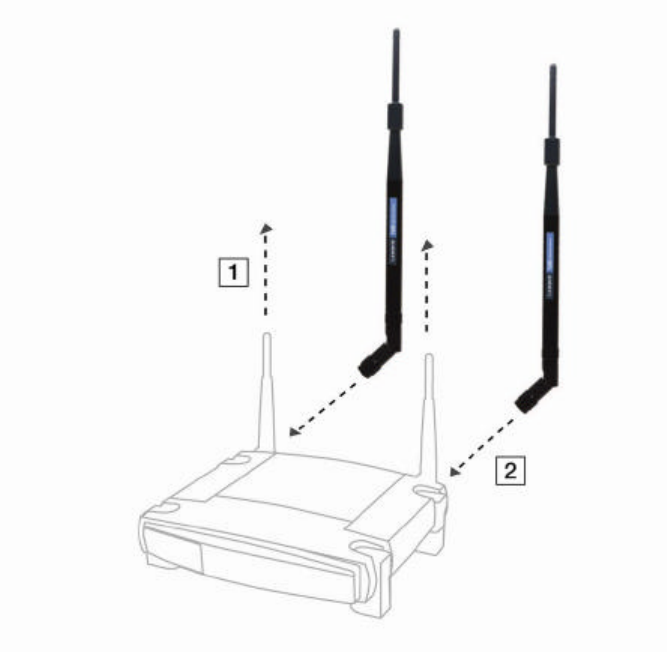
Also Available:
• Linksys High Gain Antenna for TNC Connectors (HGA7T)